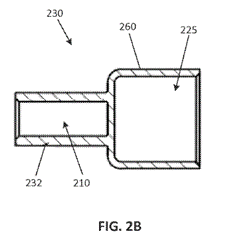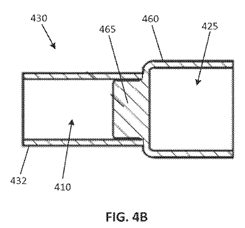Claim differentiation helps broaden the scope of a claim to a Fuse end cap
| April 29, 2022
Littlefuse, Inc. v. Mersen USA EP Corp.
Decided: April 4, 2022
Prost, Bryson and Stoll. Opinion by Bryson.
Summary:
Littlefuse sued Mersen for infringement of its patent to a fuse end cap. In construing the claims, the district court held that the claims are limited to a multi-piece apparatus even though some dependent claims recite a single-piece apparatus. Upon review of the claims, specification, and prosecution history, and based on principles of claim differentiation, the CAFC concluded that the district court’s construction is incorrect. The CAFC concluded that the independent claims should be construed as including multi-piece fuse end caps as well as single-piece fuse end caps. Thus, the CAFC vacated the district court’s judgment and remanded.
Details:
Littlefuse owns U.S. Patent No. 9,564,281 to a “fuse end cap for providing an electrical connection between a fuse and an electrical conductor.” Independent claim 1 is provided:
1. A fuse end cap comprising:
a mounting cuff defining a first cavity that receives an end of a fuse body, the end of the fuse body being electrically insulating;
a terminal defining a second cavity that receives a conductor, wherein the terminal is crimped about the conductor to retain the conductor within the second cavity; and
a fastening stem that extends from the mounting cuff and into the second cavity of the terminal that receives the conductor.
Dependent claims 8 and 9 are also important in this case and are provided:
8. The fuse end cap of claim 1, wherein the mounting cuff and the terminal are machined from a single, contiguous piece of conductive material.
9. The fuse end cap of claim 1, wherein the mounting cuff and the terminal are stamped from a single, contiguous piece of conductive material.
The specification describes three embodiments: (1) a “machined end cap” that may be manufactured from a single piece of any suitable, electrically conductive material; (2) a “stamped end cap” that may be manufactured from a single piece of any suitable, electrically conductive material; and (3) an “assembled end cap” in which the terminal and mounting cuff are formed from separate pieces of material, the material being any suitable, electrically conductive material. With the “assembled end cap,” the terminal and mounting cuff are “joined together, such as by press-fitting a fastening stem of the mounting cuff into the cavity of the terminal” or by using “a variety of other fastening means including … various adhesives, various mechanical fasteners, or welding.”
The following is an example of the “machined fuse end cap”:
And the following is an example of the “assembled end cap”:
During prosecution, the Examiner issued a restriction requirement stating that each of the three embodiments represented a distinct species. Littlefuse elected to prosecute the species corresponding to the “assembled end cap” embodiment. Claims 8 and 9 directed to the “machined end cap” and the “stamped end cap,” respectively, were then withdrawn. These dependent claims were subject to reinstatement if a generic claim was found to be allowable. Upon a rejection issued by the Examiner, claim 1 was amended to include the “fastening stem” limitation shown above. Amended claim 1 was then allowed and claims 8 and 9 were rejoined since the Examiner concluded that claims 8 and 9 require all the limitations of the allowable claims.
District Court
In the district court, the term “fastening stem” was construed to mean “a stem that attaches or joins other components”; and “a fastening stem that extends from the mounting cuff and into the second cavity of the terminal that receives the conductor” was construed to mean “a stem that extends from the mounting cuff and into the second cavity of the terminal that receives the conductor, and attaches the mounting cuff to the terminal.” The district court further construed claim 1 such that the fuse end cap “is of multi-piece construction” and that claim 1 does not cover a single-piece apparatus. The parties stipulated to non-infringement based on the district court’s construction of claim 1 as covering only a multi-piece apparatus, and Littlefuse appealed the claim construction ruling.
CAFC
The court first explained claim construction principles citing Phillips v. AWH Corp., 415 F.3d 1303 (Fed. Cir. 2005) (en banc) stating that “A claim term is generally given the meaning that the term would have to a person of ordinary skill in the art in question at the time of the invention” and that “How the term is used in the claims and the specification of the patent is strong evidence of how a person of ordinary skill would understand the term.”
The court further stated that “The structure of the claims is enlightening.” Citing Baxalta Inc. v. Genentech, Inc., 972 F.3d 1341 (Fed. Cir. 2020), the court stated that “By definition, an independent claim is broader than a claim that depends from it, so if a dependent claim reads on a particular embodiment of the claimed invention, the corresponding independent claim must cover that embodiment as well.” The court stated that if this were not the case, then the dependent claim would be meaningless, and a claim construction that leads to that result is generally disfavored. Thus, the court concluded that the recitation of a single-piece apparatus in claims 8 and 9 is persuasive evidence that claim 1 also covers a single-piece apparatus.
The court then explained principles regarding claim-differentiation stating that “the presumption of differentiation in claim scope is not a hard and fast rule” citing Seachange Int’l, Inc. v. C-COR, Inc., 413 F.3d 1361 (Fed. Cir. 2005) and that “any presumption created by the doctrine of claim differentiation will be overcome by a contrary construction dictated by the written description or prosecution history” citing Retractable Techs., Inc. v. Becton, Dickinson, and Co., 653 F.3d 1296 (Fed. Cir. 2011).
Mersen argued that notwithstanding the doctrine of claim differentiation, a construction that renders certain claims superfluous need not be rejected if that construction is consistent with the teachings of the specification citing Marine Polymer Technologies, Inc. v. HenCon, Inc., 672 F.3d 1350 (Fed. Cir. 2012) (en banc). However, the court stated that Littlefuse’s construction is supported by the specification. The court further stated that Mersen’s construction “would not merely render the dependent claims superfluous, but would mean that those claims would have no scope at all, a result that should be avoided when possible.”
The court pointed out that the district court recognized the inconsistency between its construction of claim 1 as covering only a multi-piece apparatus and the recitation of a single-piece apparatus in dependent claims 8 and 9. The district court concluded that the Examiner’s rejoinder of those dependent claims was a mistake. However, the CAFC said that the record in this case does not support the district court’s conclusion. The CAFC agreed with the Examiner that the dependent claims “require all the limitations of the … allowable claims” since the independent claims are not limited to a multi-piece construction and “the dependent claims form a coherent invention in that they each recite a fuse end cap that comprises a mounting cuff, a terminal, and a fastening stem.
The court also addressed the specification which only refers to a “fastening stem” with respect to the “assembled end cap” embodiment, which is a multi-piece apparatus. But the court said that “courts ordinarily should not limit the claimed invention to preferred embodiments or specific examples in the specification.” The court pointed out that the specification does not state that a fastening stem cannot be present in a single-piece apparatus and “one can envision a stem that projects from the side of the mounting cuff even in an embodiment in which the fuse end cap is formed from a single piece of material.”
The court concluded that the construction of “fastening stem” that is most consistent with the claims, specification, and prosecution history is a construction that includes a multi-piece end cap as well as a single-piece end cap. Thus, the court vacated the district court’s judgment of non-infringement and remanded.
Comments
Claim differentiation can be a useful tool for providing broader claim scope to independent claims. Thus, when drafting patent applications, it is a good idea to include various dependent claims.
Also, when faced with a restriction requirement due to distinct species and upon allowance of some claims, make sure to review whether other claims can be rejoined. In this case, the fact that the Examiner rejoined some species claims as being covered by a generic independent claim helped persuade the CAFC to provide a broader construction of the independent claim.




